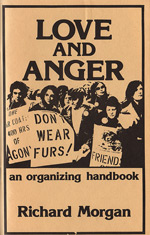Love and Anger, 1st and 2nd Editions (1980?, Westport, CT. USA)
“Animals have rights, interests, desires, and needs equal, within the context of their lives, to those of humans, and we have an obligation to recognize this, and act accordingly. Animal Rights is a philosophical orientation, and a practical necessity if creatures are to be spared the systematic cruelty to which they are currently subjected. But perhaps most importantly, the designation of and agitation for animal rights is part of a revolutionary process aimed at restructuring the major institutions of our society. Indeed, in struggling to change the way humans treat animals, and one another, we work towards nothing less than the transformation of the world.”
– Richard Morgan, from the introduction.
For the last several years, I have been trying to understand why the animal rights movement rode a wave of success in the early 80s, only to fall so sharply by the end of the decade. This inquiry has led me to read old books and magazines, to interview participants from that time period, and even to reading the history of other causes in an attempt to find parallels in their peaks and troughs. I still have not arrived at a conclusive answer to the question, and it appears that many factors played a part in our recession. What is more clear, though, is that one figure played a major role in our rise, only to be quickly forgotten. His name is Richard Morgan, and after working towards civil rights and an end to the war in Vietnam, he took up the cause of animal rights in the late 1970s.
Early figures in the movement speak of Morgan as a pioneer, and his group, Mobilization for Animals, planned some of the largest and most visible demonstrations of the time, drawing thousands of people to multiple locations across the United States. He introduced his organizing model in 1979 with the the first edition of Love and Anger, a book which many people in the fledgling animal rights community cited as their inspiration to start a local group.
Written in a style that blends 70s leftism with 80s self-help jargon, Love and Anger can, at times, be a frustrating read. Morgan certainly has a touch of the arrogant liberalism that repulsed the generation of activists that followed his into the 90s. Scattered throughout the book are unsupportable claims, like American pacifists ending the war in Vietnam with sit ins, and new-agey feel good calls for demonstrations to provide “spiritual nourishment.” Some of the book’s advice is remarkably egalitarian, including calls for work within a group to rotate and for everyone, even supposed leaders, to do “shit work.” But some of the book is strangely authoritarian, with calls for “marshals” at demonstrations to squelch the spontaneous actions of others present. If a reader can get past these snags this book also contains a lot of wisdom.
Written at a time when there was almost no movement to speak of in the United States, the author set out to make a handbook to teach people who had never held a sign before to grow a resistance from scratch. He was concerned about the personal and political development of each new member of this tiny cause, and wanted them to think big. Four years before the first civil disobedience action for animal rights (which took place in New York at the Macy’s Fur Department, not in Sacramento as widely reported elsewhere), Richard Morgan wrote about developing personal courage to face law enforcement and overcome private doubts about organizing ability. He gave practical advice on bringing out large numbers to demonstrations, making literature, contacting media and writing press releases, and other basics that helped make animal rights the breakout issue of the 1980s.
Richard Morgan disappeared from activism in the mid 80s. Attempts to track him down have been fruitless, and even his old friends don’t seem to know what happened to him. But, before he walked out of view, he left us with some powerful advice. I hope young activists will read this book with a critical eye, and consider how these words helped lay the foundation for the movement they participate in today.






